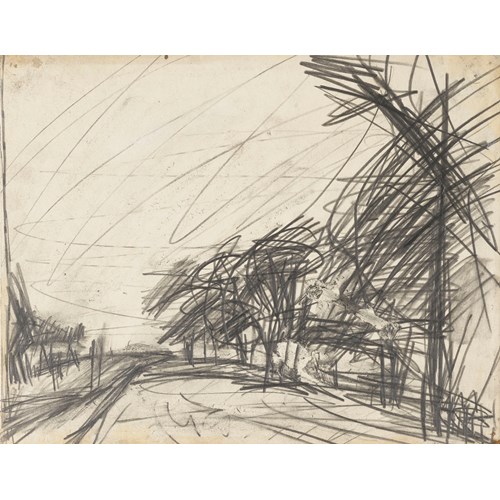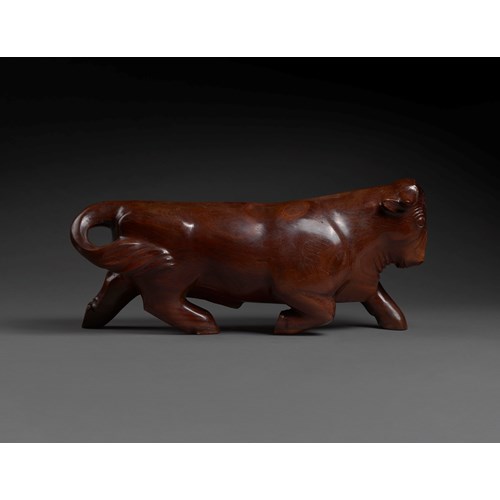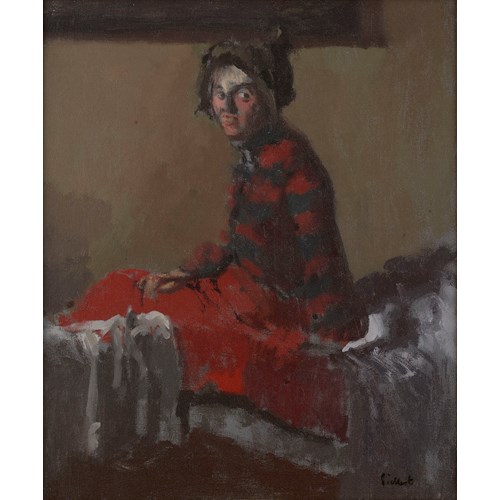Paul Nash
Studio, 1929
Date 1929
Medium Watercolour, gouache, chalk and pencil on paper
Dimension 57.3 x 41.3 cm (22¹/₂ x 16¹/₄ inches)
Following the First World War, Nash moved to the seaside town of Dymchurch on the Kent coast. Here he made a series of stark paintings depicting the relentless battle between the encroaching sea and the concrete coastal defences. This conflict between nature and man resonated with Nash’s war experience and his works of this period explore themes of threat and defence. Painted in a direct and often geometric style, the zigzagging lines of the waves and defences appear almost as lines of trenches. As the decade moved on, Nash began to return to elements of landscape painting that had occupied much of his work before the war. In 1925, Nash and his wife Margaret left Dymchurch and moved to Oxenbridge Cottage. The Nash’s home was on the outskirts of Iden and Nash himself described it as being ‘little more than a summer house.’ Nonetheless, he had a spacious studio connected to the main house by glass doors and a large window looking north on to the rolling downland hills. Throughout his life, Nash had a keen emotional attachment to the English countryside and a deep rooted sense of place. He was in many ways part of a pastoral tradition extending back to Samuel Palmer and English folkloric customs. Nash often articulated his feelings for landscape, ‘There are places … whose relationship of parts creates a mystery, an enchantment, which cannot be analysed.’ The landscape around Iden was clearly just such a place and it inspired Nash to some of his very best work.
In the same year as Studio was completed, Nash painted one of his most recognisable works Landscape at Iden, showing a view from the window of his studio out over the garden to the hills beyond. Whilst ostensibly a landscape painting, Nash is beginning to introduce elements of the surreal, a direction that would become the focus of his work during the 1930s. In Landscape at Iden Nash distorts the geometric forms of the logs, fence, and screen, creating a tangible sense of mystery and intrigue. The screen on the right of the painting creates a plane of vacant space much like the canvases in the centre of the composition of Studio. These layered angular canvases have a totemic structure, preempting the surrealist landscapes of the 1930s, such as Equivalent for the Megaliths (1935, Tate, London). Moreover, whilst Nash has avoided direct reference to the human figure in Studio, there is an unmistakeable sense that the interior contains elements of the figurative. In this way, Studio is reminiscent of the Cubist works of Pablo Picasso from the period between 1914 and 1916, where semi-distinct figures are built out of overlapping shapes and forms (fig. 2). Nash was also highly influenced by the Italian artist Giorgio de Chirico and the way he treated objects in a space. Nash was, throughout the 1920s and 30s, thoroughly international in his outlook and looked to European Modernism for direction and inspiration, with Picasso as well as de Chirico a particular influence at the time Studio was completed. Indeed, Andrew Causey remarks that ‘Studio confirms what has already been observed, that when Nash is concerned with inferring portraiture, or at least a figural reference, through semi-abstract means, he is attentive to the work of Picasso and de Chirico at the points at which those two painters are at their closest.’ (Andrew Causey, Paul Nash, Oxford University Press, Oxford, 1980, p. 184)
Although not realised as an oil painting, Studio remains a complete work in its own right. Indeed, Causey noted the period of the late 1920s as yielding many of Nash’s most important pictures, with the balance of his practice shifting back to watercolour. The most direct comparison to Studio is a painting of the same year Token (fig. 3). The work is a geometrical composition of an interior in which the lines of the artist’s easel (the same easel that features in Studio) are set off against the angle of the painting in the background and the corner of the room. Nash, like de Chirico, was intrigued by the possibilities of representing a three-dimensional space in a two-dimensional work and commented that, ‘we have at once the problem of intruding upon a space with certain forms - squares, parallelograms, ovals and so on - which constitute furniture […] and which by their disposition involve planes, horizontal, vertical and inclined, angles, right acute and obtuse, directions, divisions, dimensions and recessions; contrasts of masses, light and shade - in fact, the basic material for creating the structural harmony.’ (Paul Nash, Room and Book, London, 1932, p. 49) In Studio, Nash can be observed employing much of the above to render the interior space of his studio. The composition is subtly complex with the overlapping forms, shapes and angles of the French doors, canvases, picture frames, easel, furniture, paint brushes and box layered on top of each other in a delicate balance.
Studio was originally owned by the prominent art critic R. H. Wilenski. Wilenski, encouraged by his friend the publisher Geoffrey Faber, wrote his major work, The Modern Movement in Art (Faber & Gwyer, London), in 1927. The next year he wrote his first piece on the work of Paul Nash titled Paul Nash, Painter of Symphonic Landscapes (Britannia, 9 November 1928, pp. 607-8). Nash and Wilenski began a regular correspondence that developed in to a close friendship. Studio was illustrated in an article by Wilenski in 1930 (R.H. Wilkenski, ‘Carpaccio and Paul Nash’, Studio, December 1930) and it is very likely that Wilenski acquired the work from Nash at this time. Following Paul Nash’s death in 1948, Wilenski lent Studio to the memorial exhibition organised by the Tate Gallery and the Arts Council. Later that year, Studio was included in an exhibition held at The Leicester Galleries in London, where it was acquired by Mr A. D. Goodwin and it has remained in the same private family collection since.
Date: 1929
Medium: Watercolour, gouache, chalk and pencil on paper
Signature: Signed and dated Paul Nash / 1929 (upper left)
Dimension: 57.3 x 41.3 cm (22¹/₂ x 16¹/₄ inches)
Provenance: R. H. Wilenski
The Leicester Galleries, London, where acquired by A. D. Goodwin, Esq., in 1948
By family descent to 2024
Acquired from the above
Literature: Reginald Howard Wilkenski, ‘Carpaccio and Paul Nash’, Studio, December 1930 Paul Nash, ‘Notebook I’, unpublished, n.p.
Herbert Read (ed.), Unit One: The Modern Movement in English Architecture, Painting and Sculpture, Cassell and Company, London, 1934, illustrated p. 86
Margot Eates (ed.), Paul Nash, Paintings, Drawings and Illustrations: A Memorial Volume, Lund Humphries, London, 1948, illustrated pl. 55
Paul Nash, ‘The Artist’s Photographic Record of Work 1912-1939’, vol. I, no. 24, unpublished, n.p.
Anthony Bertram, Paul Nash, The Portrait of an Artist, Faber and Faber, London, 1955, p. 163
Margot Eates, Paul Nash, Master of the Image, 1889-1946, John Murray, London, 1973, p. 42
Andrew Causey, Paul Nash, Oxford University Press, Oxford, 1980, pp. 183-4, 409, cat. no. 660, illustrated pl. 215
Exhibition: London, Tate Gallery, Paul Nash, A Memorial Exhibition, March 1948, no. 102, with Arts Council provincial tour, lent by R. H. Wilenski Esq.
London, The Leicester Galleries, Artists of Fame and Promise, Pt. 1, July 1948, no. 36.
More artworks from the Gallery





_T638354709335648178.jpg?width=500&height=500&mode=pad&scale=both&qlt=90&format=jpg)



